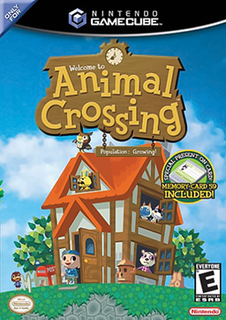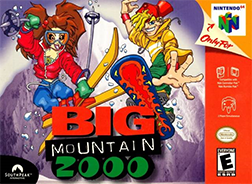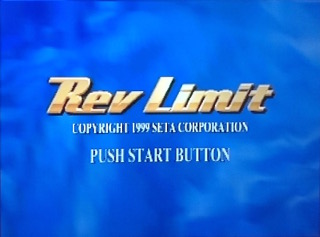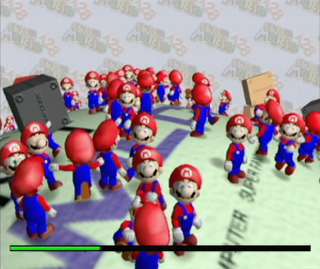 W
WAnimal Crossing is a life simulation video game developed and published by Nintendo. It is a localized version of Dōbutsu no Mori, a Nintendo 64 game that was released in Japan on April 14, 2001. It was enhanced and re-released on the GameCube in Japan later that year as Dōbutsu no Mori+, which was localized worldwide as Animal Crossing. Another version, Dōbutsu no Mori e+, was released in Japan in 2003, adding the improvements made to Animal Crossing plus some additional features. It received critical acclaim from reviewers and sold relatively well, with many publications naming it one of the greatest video games of all time.
 W
WBig Mountain 2000, known in Japan as Snow Speeder , is a Snowboarding video game for the Nintendo 64.
 W
WCaptain Commando is a 1991 futuristic side-scrolling beat 'em up video game originally developed and published by Capcom as a coin-operated arcade video game, and later ported to several other platforms. It was the seventeenth title produced for the company's CP System hardware. The game stars the titular superhero who was originally conceived as a fictional spokesman used by Capcom USA in the company's console games during the late 1980s. On September 13, 2018, Capcom announced Capcom Beat 'Em Up Bundle with Captain Commando being one of seven titles and released digitally for PlayStation 4, Nintendo Switch, Xbox One and Microsoft Windows on September 18, 2018.
 W
WCubivore: Survival of the Fittest, known in Japan as Dōbutsu Banchō is an action-adventure video game co-developed by Saru Brunei and Intelligent Systems for the GameCube. It was originally published by Nintendo only in Japan on February 21, 2002. After Nintendo expressed intentions to not release the game in other regions, Atlus localized it for North America on November 10, 2002.
 W
WDragon Quest VII: Fragments of the Forgotten Past is a Japanese role-playing video game developed by Heartbeat and ArtePiazza, and published by Enix for the PlayStation in 2000. It was released in North America in 2001 under the title Dragon Warrior VII. The game received a remake on the Nintendo 3DS on February 7, 2013 in Japan, which was released in North America and Europe for the Nintendo 3DS under the title Dragon Quest VII: Fragments of the Forgotten Past in 2016. A version of the game for Android and iOS was also released in Japan on September 17, 2015.
 W
WFire Emblem: The Binding Blade is a tactical role-playing game developed by Intelligent Systems and published by Nintendo for the Game Boy Advance (GBA) handheld video game console. It is the sixth entry in the Fire Emblem series, the first title produced for the system, and the first title to appear on a handheld console. It was released in Japan in March 2002.
 W
WHybrid Heaven is a video game developed by Konami Computer Entertainment Osaka and released for the Nintendo 64 in 1999. This game is most notable for its peculiar mix of genres: it has aspects of both role-playing video games and action-adventure games. The designers had hoped to create a "new style RPG battle system". It is also one of the few Nintendo 64 titles to support a widescreen mode.
 W
WKirby 64: The Crystal Shards is a 2000 platform game developed by HAL Laboratory and published by Nintendo for the Nintendo 64 (N64). It is the first Kirby game to feature 3D computer graphics and follows Kirby as he attempts to reassemble a sacred crystal shattered by Dark Matter. Gameplay is viewed from a 2.5D perspective and is similar to previous Kirby titles; the player traverses levels and obtains powers by eating enemies. Kirby 64 introduces Power Combos, the ability to mix powers to create more powerful ones. In a multiplayer mode, up to four players can compete in three minigames.
 W
WThe Legend of Zelda: Majora's Mask is an action-adventure game developed and published by Nintendo for the Nintendo 64. It was released in 2000 as the sixth main installment in The Legend of Zelda series and was the second to use 3D graphics, following 1998's The Legend of Zelda: Ocarina of Time, to which it is a direct sequel. Designed by a creative team led by Eiji Aonuma, Yoshiaki Koizumi, and Shigeru Miyamoto, Majora's Mask was completed in less than two years. It featured enhanced graphics and several gameplay changes from its predecessor, though it reused a number of elements and character models, which the game's creators called a creative decision made necessary by time constraints.
 W
WThe Legend of Zelda: Ocarina of Time is an action-adventure game developed and published by Nintendo for the Nintendo 64. It was released in Japan and North America in November 1998, and in PAL regions the following month. Ocarina of Time is the fifth game in The Legend of Zelda series, and the first with 3D graphics.
 W
WMario Artist is an interoperable suite of three games and one Internet application for Nintendo 64: Paint Studio, Talent Studio, Polygon Studio, and Communication Kit. These flagship disks for the 64DD peripheral were developed to turn the game console into an Internet multimedia workstation. A bundle of the 64DD unit, software disks, hardware accessories, and the Randnet online service subscription package was released in Japan starting in December 1999.
 W
WMission: Impossible is an action-adventure video game developed by Infogrames and loosely based on the 1996 film of the same name. It was originally released for the Nintendo 64 video game console in 1998. In the game, the player assumes the role of Ethan Hunt, an Impossible Missions Force (IMF) agent who must clear his name after a mole has infiltrated the IMF team. The game features 20 levels where the player must complete several mission objectives with the use of numerous high-tech gadgets.
 W
WMorita Shogi 64 (森田将棋64) is a Japanese virtual board game for the Nintendo 64. It was released only in Japan in 1998. It is the sequel to Saikyō Habu Shōgi, a launch game for the Nintendo 64.
 W
WMother 3 is a role-playing video game developed by Brownie Brown and HAL Laboratory and published by Nintendo for the Game Boy Advance. The final entry in the Mother series, it was released in Japan on April 20, 2006. The game follows Lucas, a young boy with psychic abilities, and a party of characters as they attempt to prevent a mysterious invading army from corrupting and destroying the world.
 W
WOnimusha: Warlords, known in Japan as Onimusha , is an action-adventure video game and the first entry of the Onimusha series, released for the PlayStation 2 in 2001. An updated form as Genma Onimusha for the Xbox was released in 2002. The original Warlords version was ported to Microsoft Windows, although it was only available in China and Russia. A remaster for Nintendo Switch, PlayStation 4, Xbox One and Windows via Steam was released on January 15, 2019.
 W
WPaper Mario is a role-playing video game developed by Intelligent Systems and published by Nintendo for the Nintendo 64 home video game console. The first game in the Paper Mario series of Mario role-playing games, it was first released in Japan in 2000 and then internationally in 2001. Paper Mario was re-released for Nintendo's Wii Virtual Console in July 2007 as well as Wii U Virtual Console in 2015.
 W
WPokémon Snap is a first-person simulation video game with rail shooter style gameplay mechanics co-developed by HAL Laboratory and Pax Softnica and published by Nintendo for the Nintendo 64. It was first released in Japan in March 1999, and was later released in June 1999 in North America and in September 2000 for PAL regions. It is a spin-off game in the Pokémon series, being one of the first console-based games for it, and featuring many Pokémon rendered for the first time in real-time 3D. The game was re-released for the Wii's Virtual Console in December 2007 as well as Wii U's Virtual Console in 2016.
 W
WPokémon Stadium is a strategy video game developed and published by Nintendo for the Nintendo 64 video game console. First released in Japan on April 30, 1999, it was later released as the first Stadium title in Western regions the following year, and is a sequel to the Japanese-only 1998 Nintendo 64 release Pocket Monsters Stadium. The gameplay revolves around a 3D turn-based battling system using the 151 Pokémon from the Game Boy games Pokémon Red, Pokémon Blue, and Pokémon Yellow.
 W
WPuyo Puyo~n , also known as Puyo Puyo 4, and Puyo Puyo~n Party is the fourth installment of the Puyo Puyo puzzle game series, created by Compile for the Dreamcast, PlayStation, Nintendo 64 and Game Boy Color. Like many of the Puyo Puyo games, it was never officially released outside Japan. The title of Puyo Puyo~n comes from the Japanese word yon , signifying the fourth game in the series. Plans were made for a 64DD version entitled Puyo Puyo~n 64 , but it was later cancelled for the N64 release.
 W
WRev Limit is an unreleased sim racing video game that was in development and planned to be published by Seta Corporation in May 1998 for the Nintendo 64. It was also intended to be the first arcade title to use Seta's own Aleck 64 arcade board, and was planned for the 64DD as well. It was one of the earliest original third-party racing titles to be announced for the system. In the game, players compete against either computer-controlled vehicles or other human opponents across several tracks of varying thematic in order to reach first place and advance to the next course.
 W
WSamurai Shodown 64: Warriors Rage, known as Samurai Spirits 2: Asura Zanmaden in Japan, is a 3D fighting game produced by SNK for its Hyper Neogeo 64 system. It is the followup to the original Samurai Shodown 64 on the same platform, and like its predecessor, it received relatively little distribution outside Japan.
 W
WShiren the Wanderer 2: Demon Invasion! Shiren Castle is a role-playing video game developed by Chunsoft and published by Nintendo for the Nintendo 64. It is the second main entry in the Shiren the Wanderer series, which is part of the larger Mystery Dungeon series, and was originally released in Japan on September 27, 2000. The game follows Shiren, a boy who aims to defend a village from attacking demons by building a castle; he finds building materials and other items by exploring dungeons.
 W
WSimCopter is a 1996 flight simulator video game, developed by Maxis. It puts the player into a 3D city. Like Streets of SimCity, SimCopter lets the user import SimCity 2000 maps into the game. It is also the first game to use the Sim language Simlish.
 W
WSuper Mario 128 was a codename for two different development projects at Nintendo. The name was first used in 1997 for a sequel to Super Mario 64 for the 64DD, which was canceled. The name was reused for a GameCube tech demo at the Nintendo Space World trade show in 2000. Nintendo gradually incorporated the demonstrated graphics and physics concepts into the rapid object generation of Pikmin (2001), the physics of Metroid Prime (2002), and the sphere walking technology of The Legend of Zelda: Twilight Princess (2006) and Super Mario Galaxy (2007). The Super Mario 128 demo intrigued widespread analysis, rumors, and anticipation in the media throughout the 2000s.
 W
WUnreal is a first-person shooter video game developed by Epic MegaGames and Digital Extremes and published by GT Interactive in May 1998. It was powered by Unreal Engine, an original game engine. The game reached sales of 1.5 million units by 2002.
 W
WYoshi's Story is a side-scrolling platform game published and developed by Nintendo for the Nintendo 64. It was first released in Japan in December 1997, and worldwide the following year. It was re-released on the Wii's Virtual Console service in 2007, and later for the Wii U's Virtual Console in 2016.